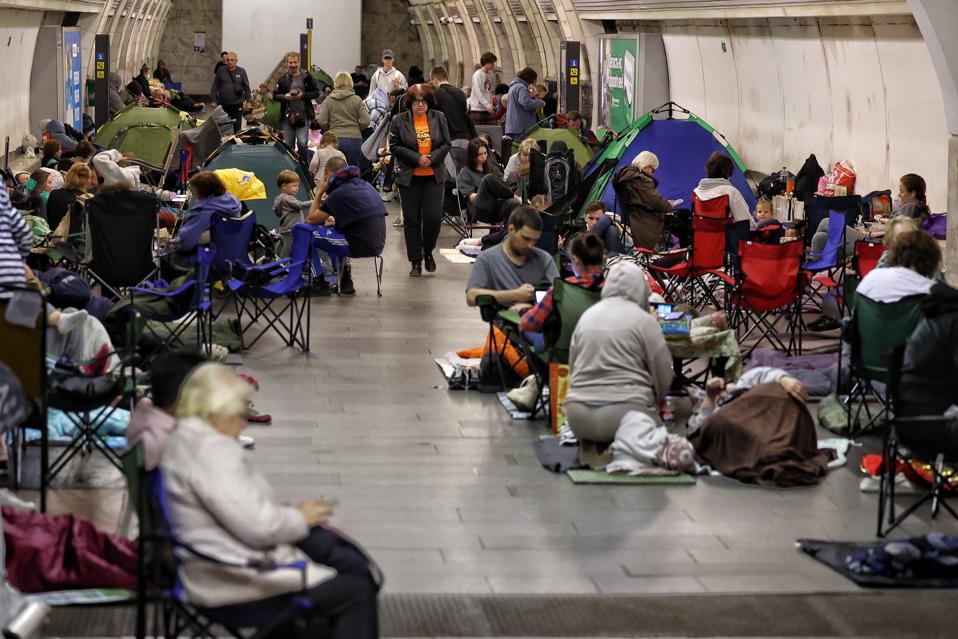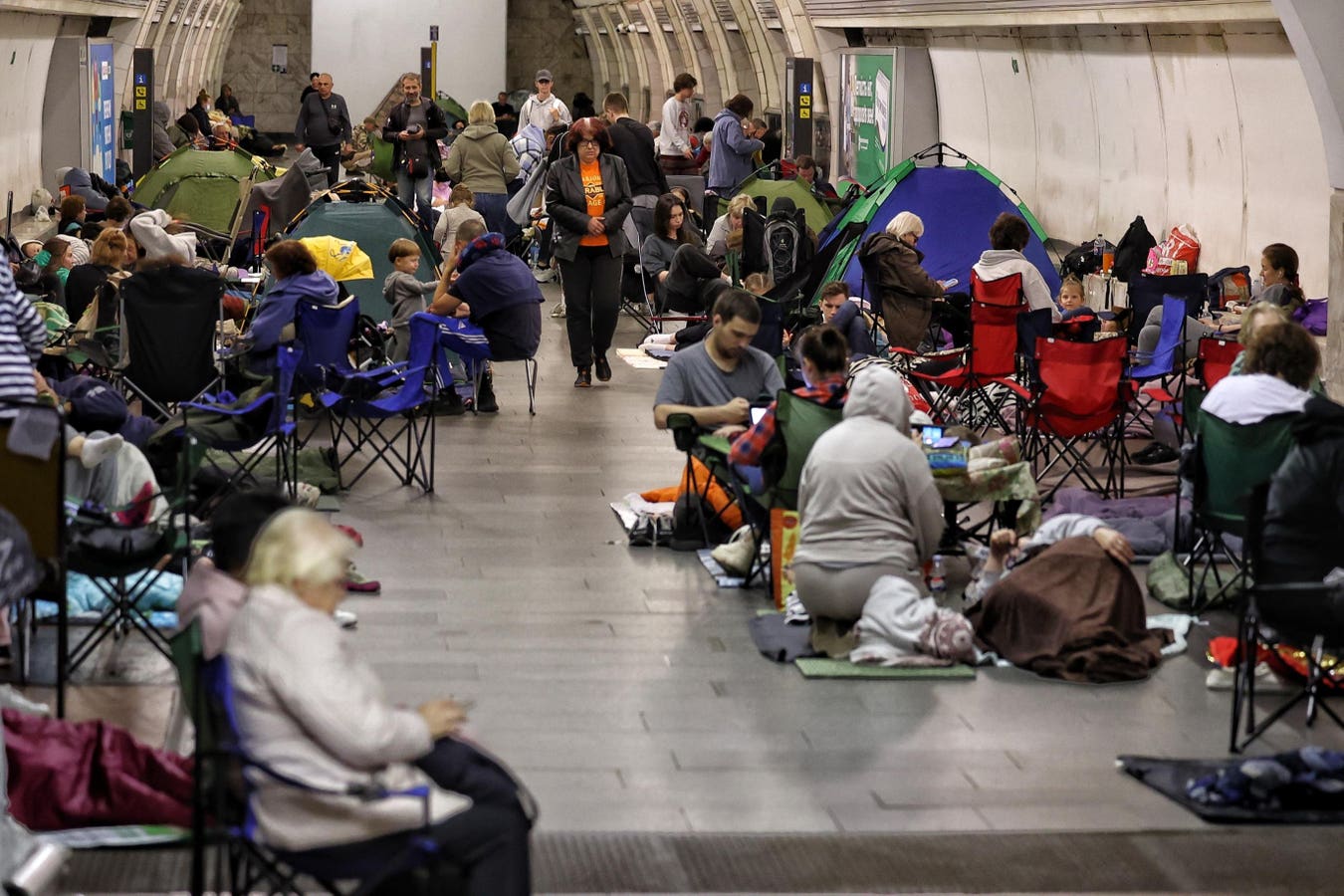
KYIV, UKRAINE – JULY 21: People took shelter at subway station during Russian drone-and-missile … More attack on July 21, 2025 in Kyiv, Ukraine. Several districts of the capital were damaged in result of attack. According to the Ukrainian Air Force, the Russian army launched on Ukraine 426 drones and 24 missiles. (Photo by Yan Dobronosov/Global Images Ukraine via Getty Images)
Global Images Ukraine via Getty Images
Dispatches from Ukraine. Day 1,244
Russian Attacks on Ukraine
Overnight into July 21, Russian forces blasted Ukraine with 450 aerial weapons, including five Kinzhal hypersonic missiles. Ukraine’s Air Force intercepted all 24 missiles and 200 drones while electronically jamming another 203 drones. The attacks killed one civilian in Kyiv and wounded at least 33 people in Kharkiv, Ukraine’s second-largest city. In addition, the multi-vector attack struck western Ivano-Frankivsk in the most extensive strike on the regional capital since the start of the war. This latest barrage follows a similar July 19 attack, when Russia launched 344 drones and 35 missiles, of which Ukrainian forces downed 314 drones and 30 missiles.
Improved engineering has tripled the strike accuracy of Russian drones since early 2025, according to a Financial Times analysis. From April to June, 2025, some 15% of Russian drones reportedly reached their targets, compared to about 5% earlier this year. Much of the increase is due to Russian drones’ new technical capabilities and improved engineering. “The problem is not [that]
the Ukraine air defense is getting worse. Instead…drones are now flying at higher altitudes, [which] makes them more effective,” said Yasir Atalan of the Center for Strategic and International Studies.
Another challenge lies in Russia’s evolving drone deployment strategy. With rising production, Moscow is now simultaneously dispatching large swarms of drones, concentrating them on selected targets rather than chaotically scattering them across the country. “Instead of deploying 500 drones nationwide like they used to, Russian forces now target one or two cities at a time,” said Oleksandr Matviienko, a drone expert at Counteroffensive Pro, a Ukrainian defense technology outlet. Russian overnight attacks might escalate further in line with the Kremlin’s rapidly increasing drone manufacturing. At present, Ukrainian intelligence estimates Russian production at about 170 units daily, with plans to boost output to 190 by year’s end.
Russian daytime strikes, scattered across Ukraine, killed at least 22 civilians between July 18 and July 21. In eastern Donetsk region, systematic Russian shelling killed 13 civilians and wounded 33 others. In the southern Kherson region, Russian drones killed three civilians and wounded 29 others; in central Dnipropetrovsk province, drones killed four people and wounded another 12. Russian shelling killed one civilian each in the northern Sumy and southern Zaporizhzhia regions.
International
Ukrainian President Volodymyr Zelenskyy has proposed a new round of peace talks with Russia. After a month-long stalemate in negotiations, President Zelenskyy called for talks focused on a ceasefire, prisoner-of-war exchanges and the return of Ukrainian children deported to Russia. He reiterated his offer for a direct meeting with Russian President Vladimir Putin, proposing Istanbul as the possible venue. Previous rounds of bilateral talks, which took place in Turkey in May and June, yielded no substantial agreements except POW swaps.
According to Zelenskyy, Ukrainian national security adviser Rustem Umerov has already communicated Kyiv’s proposal to the Russian side. Prospects for a comprehensive ceasefire, however, appear limited as Russia continues to demand a broad set of concessions from Ukraine. These include a permanent ban on NATO membership, recognition of Russian control over occupied territories and significant limitations on Ukraine’s military capabilities. Ukrainian officials have consistently described these terms as unacceptable.
The European Union adopted its 18th sanctions package against Russia on July 18. At the heart of the package is a new oil price cap, set at 15% below the average market rate. This brings the current cap to about $47.60 per barrel. EU shipping and insurance companies will no longer be allowed to handle Russian oil sold above the lowered price limit. Although the cap mirrors a G7 mechanism, U.S. reluctance to support a lower price forced the EU to act independently.
In parallel, the EU sanctioned India’s Vadinar refinery, part-owned by Russia’s largest state-owned oil company, Rosneft. In response, India’s external affairs ministry said that India “does not subscribe to any unilateral sanction measures” and urged an end to “double standards” in energy trade. The EU also blacklisted 105 more tankers from Russia’s “shadow fleet,” which it uses for illegal oil shipments and to avoid restrictions, bringing the total to more than 400. Additional bans now apply to a private international flag registry operator and an entity in the Russian LNG sector.
By Danylo Nosov, Alan Sacks

